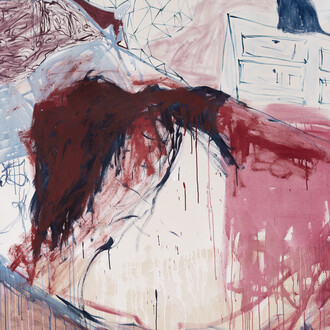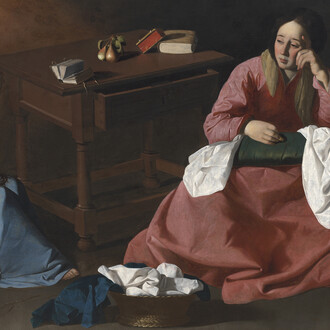Bex Massey’s paintings carry a soft realism, images rendered in oil paint are displayed in relational pairs, usually two per canvas. A selected image appears beside its counterpart, the combination forms the start of a visual equation waiting to be balanced by you, the viewer.
Over the eleven works that comprise this new body, certain consistent factors are quickly discernible. Sweet foodstuffs reoccur, familiar but not contemporary, these are the desserts we gorged on as children. Pineapple rings are cropped suggestively and a donut has a bite missing, revealing its red, jam-filled interior. The desserts are also presented in detail, as close up layers of sensuous, oozing trifle, folds of cream and fruits, berries and seeds. Parallels in the structure of each image create connections between the paired objects, the peaks of a cupcake’s icing subtly match the layered petals in the accompanying image of a rose below it, forming a visual echo.
Viewers familiar with Massey’s territory know that their images acknowledge female bodies with playful sexual charge. The works have a clean, cold tone though, that we don’t tend to associate with these sorts of connotations. Massey is using the visual innuendo of bawdy seaside humour, innuendo that doesn’t refer just to the pleasure of sex but instead to its genetic imperative, the mechanics of reproduction. Party balloons resemble cellular clusters; a floating bubble implies an ovum or petri dish; a scoop of mint chocolate chip ice cream suggests something embryonic.
Each painting is named after a Greek god and imagery in the works also contains allusions to these figures. Massey gives each work a doubled visual symbolism, implying bodies and gods in the same concise, cropped image. The choice of deities such as Phanes, Artemis, Demeter and Priapus relates to their roles in antiquity, respectively the gods of creation; protection of women and children; motherhood and sexual potency. The show title itself, Ágalma, is an ancient Greek word with a broad meaning encompassing ornament, gift, image and statue within the context of ritual offering. Beyond its literal meanings, ágalma also carries symbolic and cultural significance, relating to concepts of beauty and honor. The show speaks of these rituals and offerings, each painting is a votive in the hope of divine favour and procreation. The sacrificial foodstuffs and idols are underscored by Massey’s accompanying sound work and the diffusion of teenage antiperspirant, hanging in the air like incense. This exhibition acts as a literal ágalma then, a heartfelt prayer from the artist to the Gods.














